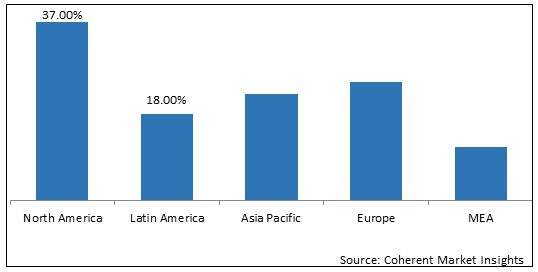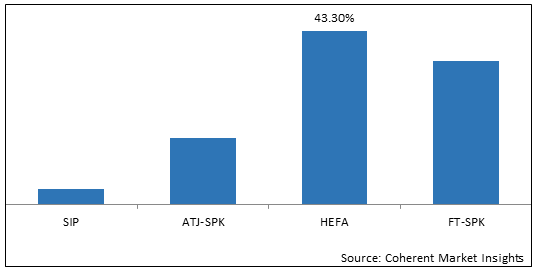Biomass based aviation fuels are considered as a promising alternative for conventional fossil fuel based aviation fuels. Bio jet fuel is made from vegetable oils, sugars, animal fats and waste biomass, and can be used in existing aviation jet engines without any modification. The first test flight with bio jet fuel was completed in 2008 by Virgin Atlantic.
Global renewable/bio jet fuel market was valued at US$ 186.81 Mn in 2021 in terms of revenue, exhibiting a CAGR of 17.95 % during the forecast period (2022 to 2030).
Drivers
Increasing need for reduction in GHG emissions in aviation industry
Sustainable aviation fuels are a key component in meeting the aviation industry’s commitments to decouple increases in carbon emissions from traffic growth SAF gives an impressive reduction of up to 80 % in CO2 emissions over the lifecycle of the fuel compared to fossil jet fuel, depending on the sustainable feedstock used, production method, and the supply chain to the airport. According to the IATA fact sheet, SAF will be an eligible option for aircraft operators to Organization (ICAO) agreed on a Carbon Offsetting and Reduction Scheme for International Aviation (CORSIA) to reduce CO2 emissions from international aviation with a pilot phase from 2021-2023, followed by a first from phase 2024- 2030
The COVID-19 pandemic disrupted the market severely. The pandemic led to lockdowns to control the virus, which resulted in minimal aviation traffic, thereby declining the demand for aviation fuel. Factors such as government policies and efforts to limit emissions from the aviation industry and increasing growth in air traffic, are some of the major factors driving the market. However, renewable aviation fuel is more expensive than conventional jet fuel, and this cost premium may restrain the market growth during the forecast period.
Figure 1. Global Renewable/Bio Jet Fuel Market Value Share (%), By Region, 2021

To learn more about this report, Download Free Sample
Market Restraints
Inadequate availability of feedstock and refineries to meet SAF production demand
The biological and non-biological resources such as oil crops, sugar crops, algae, waste oil, etc. are the raw materials that play an important role in the entire production chain of alternative aviation fuels such as synthetic fuels, e-fuels, and bio jet fuels. The demand for sustainable aviation fuel can come to a standstill due to the inadequate supply of raw materials required for its production. Also, limitations of refineries that play a major role in the proper utilization of these feedstock’s add to the delay of the overall process of SAF production. The low availability of fuel also becomes a hurdle for the blending capacity of the fuel, leading to less efficiency.
Renewable/Bio Jet Fuel Market Report Coverage
| Report Coverage | Details | ||
|---|---|---|---|
| Base Year: | 2021 | Market Size in 2021: | US$ 186.81 Mn |
| Historical Data for: | 2017-2020 | Estimated Year: | 2022 |
| Forecast Period 2022 to 2030 CAGR: | 17.95 % | Forecast Period: | 2022-2030 |
| Geographies covered: |
|
||
| Segments covered: |
|
||
| Companies covered: |
Gevo, Inc., Red Rock Biofuels LLC, Honeywell International Inc., Virent Inc., Fulcrum BioEnergy, Inc., Neste Oil Corporation, AltAir Paramount LLC, S.G. Preston Company, SkyNRG BV, Eni SpA Total S.A., and BP PLC |
||
| Growth Drivers: |
|
||
| Restraints & Challenges: |
|
||
Uncover macros and micros vetted on 75+ parameters: Get instant access to report
Market Trends
Hydroprocessed Esters and Fatty Acids (HEFA) Technology to Dominate the Market
Figure 2. Global Renewable/Bio Jet Fuel Market value Share (%), By Conversion Technology, 2021

To learn more about this report, Download Free Sample
Recent Developments
Competitive Section
Major players operating in the global renewable/bio jet fuel market include Gevo, Inc., Red Rock Biofuels LLC, Honeywell International Inc., Virent Inc., Fulcrum BioEnergy, Inc., Neste Oil Corporation, AltAir Paramount LLC, S.G. Preston Company, SkyNRG BV, Eni SpA Total S.A., and BP PLC
Share
Share
Missing comfort of reading report in your local language? Find your preferred language :
Transform your Strategy with Exclusive Trending Reports :
Frequently Asked Questions
Select a License Type
Joining thousands of companies around the world committed to making the Excellent Business Solutions.
View All Our Clients